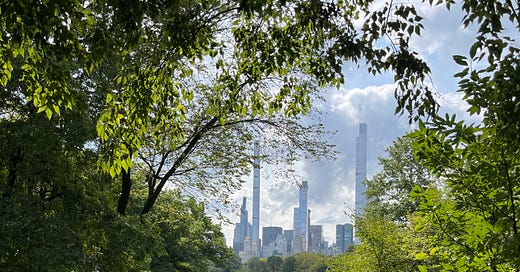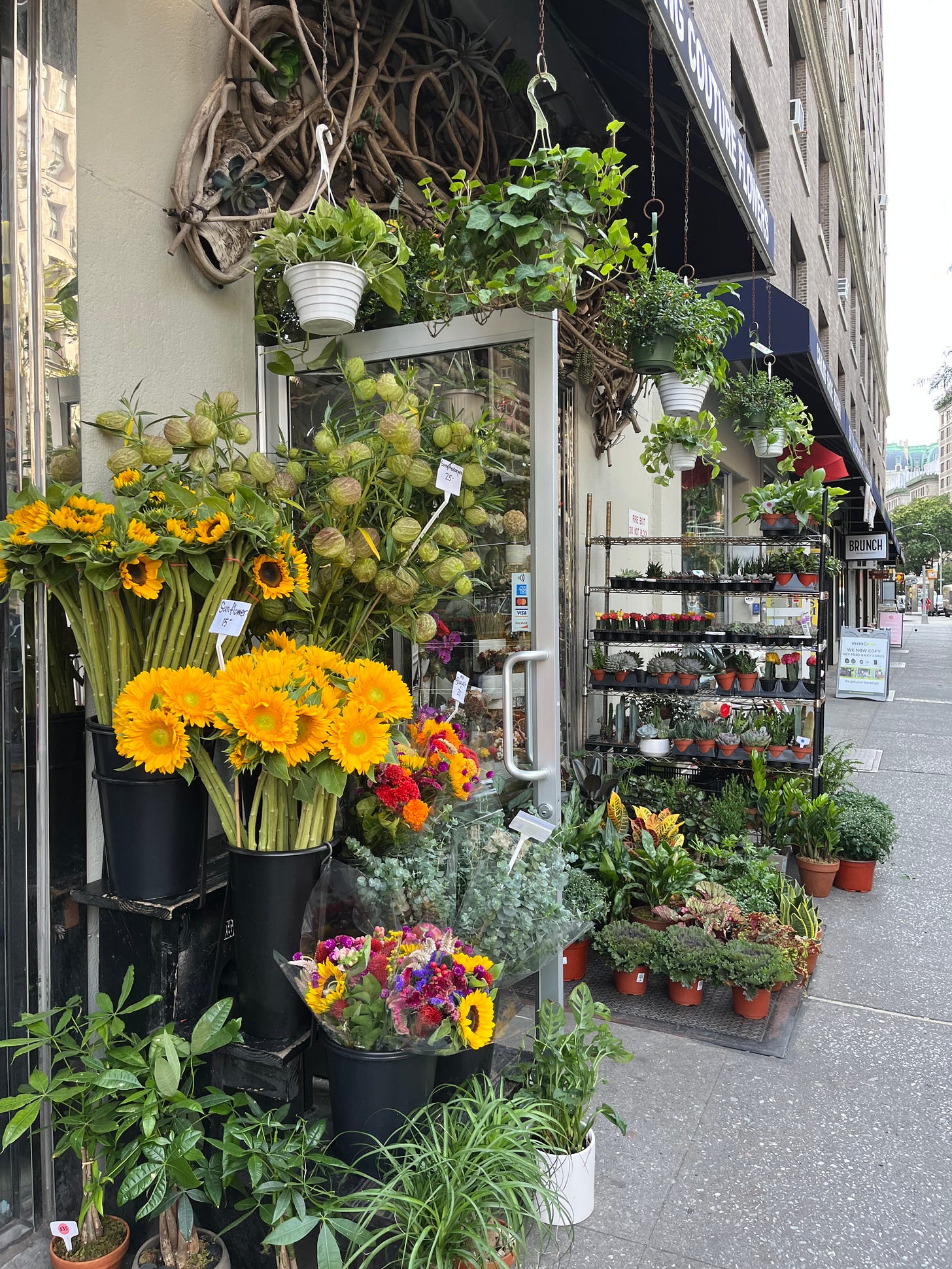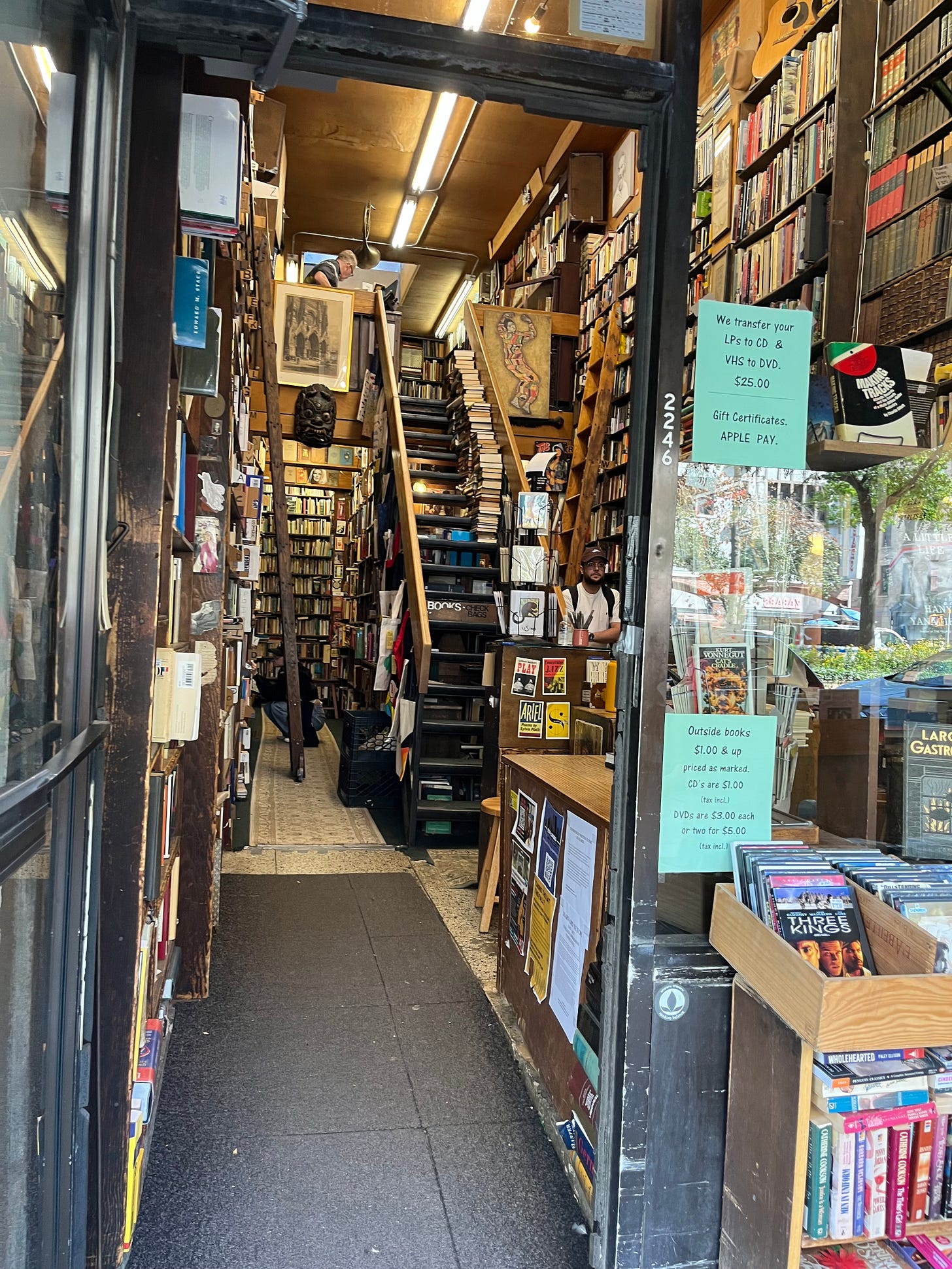[Image: NYC skyline as seen from the Ramble trail in Central Park, 9/22/2023. Snapped with my phone, as were all other photos in this post.]
Welcome, new subscribers! (Wow, there are a lot of you.) I am glad you’re here.
They say it takes three times as long to unpack the mind from travel as it takes to unpack the suitcase. I’ve still got quite a few things in my bag from last week, when I went up to read from my new collection Fragile Objects. To say this opportunity was a gift is to say too little, though it was a gift for which I’m beyond grateful.
I want to say it was a turning point. But what do we ever know about the story we’re living in? We like to pretend we write it. This is only partially true. We’re at our best in it when we are actively receptive to what’s presently happening, but we don’t know where the plot is taking us.
It keeps on surprising folks to hear that I’d never been to New York City before. Why that should be surprising I don’t know. John Gardner sure got into my head about it in the years when I was living in the DC area and marking up my copy of The Art of Fiction on the metro ride to and from work. In that book, Gardner says a writer shouldn’t attempt to depict New York, or for that matter any city, unless that writer had spent significant time there to the point of being able to pin down every last aspect to perfection, right down to the direction of the flow of traffic on one-way streets.
I disagreed with Gardner there. For one thing, most of us don’t know the flow of traffic on all the one-way streets even of cities we’ve lived years in, especially if we lived there car-free. To insist that this level of detail must always make up a necessary component of the novelist’s trade seems pedantic and plodding to a degree even I can’t fathom. If the detail truly affects the course of your story, sure, you have to get it right. Gardner’s larger point, “Don’t make glaring errors about obvious matters of fact,” is valid. But the flow of traffic?—come on: how often could you not just find another workaround for your plot, one that swung from a hinge less tediously squeaky?
Anyway, the other and larger issue was that the New York that my first novel’s characters had to pass through on their diverging ways would have to be in some ways mythical—not only because it would track, imaginatively, to the mythical city most of us have grown up knowing from books and films, but because the events that transpired in the city themselves held a mythical lore-quality in their influence on the characters’ later lives.
Still, Gardner’s literalism got in my way for years, stupidly. Why didn’t I just get on a bus and go up there to see things for myself? It wouldn’t have been that hard, at the time. It’s not like anyone was stopping me. But we tend to get in our own ways. Well, maybe you don’t. But I do.
Do you know the play Heroes of the Fourth Turning? It’s about a friend-group of young sheltered Catholics, half of whom are carrying severe damage inflicted on them by mainstream culture, half of whom are enchanted and attracted by that same culture. It provides a vivid portrait of a certain type of cultural psyche, which just so happens to track extremely closely to certain aspects of the place where I grew up.
That play lives in my head rent-free. It’s only by making reference to its character conflicts that I can access the best way I have of explaining why I was afraid for so long to go to New York: like the awkward, self-loathing, socially shy Kevin, I was afraid I’d love it. I was afraid I’d never want to leave.
Well, I don’t have to be afraid of that anymore. I loved it as a place to visit, and I want to go back for that purpose soon and often. It’s not just one enchanting world, it’s several, all layered over and nested within each other. Still, I am a rooted creature with a continual craving for accesses of quiet and solitude, so I doubt I’d flourish there in the long term.
Then again, I could always be wrong.
Another thing my first novel concerns itself with, as its people pass through this place on their way to more open though equally predetermined spaces, is the lure and danger of the illusory selves we see in others’ mirrors and in others’ (often misread) reactions. It is about not getting too attached to, or too revulsed by, those illusions. It is about the responsibility to see others’ souls as being equally real with our own.
To what extent does what we choose to notice, what we focus on, reveal that mystery of the personal? To what extent does it conceal it? What we miss can be just as telling as what we pick up: and what those characters miss, at first, is each other—completely. In their obliviousness to each other, they also miss some key things about themselves. And it isn’t as if, naively, possessing those keys could have prevented the sufferings or evils that happen along: not at all. The good of self-knowledge is not that it helps us escape pain but that it allows us to countenance things as they are, rather than as we would have them be.
Apropos of the mystery of personality, it was a real delight to stumble across the original of my novel’s cover image, a tanagra figurine from ancient Greece. I didn’t expect to see her on my visit to the Met; my hosts and I just happened to be wandering through the ancient collection when I spotted her. Though she isn’t mentioned in the text, I can easily imagine the narrator during her New York stint spending time in front of her on account of one of those hard-to-explain fascinations we so often acquire with a single piece of art. Her image is in the public domain, and this substack isn’t monetized, so I’m hoping that sharing my serendipity with you falls under the “personal use” which is okay for photographs taken in the museum. If it turns out not, I’ll take it down, naturally.
All this and I haven’t said a word about the readings themselves. Next time I’ll plan on that, with a little more of substance about the stories I read or read from, and about some of the conversations with readers that set the tone and, really, made the trip.










